
From its inspiring viewpoint, 2519 Carman Crest Drive keeps watch over Runyon Canyon, believed to have been a camp spot for the Gabrielino-Tongva, who have resided in the Los Angeles area for thousands of years. After California became a U.S. territory following the signing of the Treaty of Guadalupe Hidalgo, the canyon land that would become Runyon Canyon was said to be a hideout for Tiburcio Vasquez–the gentleman bandit. Vasquez was born in 1835 in Monterey, California, in what was at the time, Mexico, and was a notorious outlaw who was active throughout California during the 1850s-’70s. Vasquez claimed that his lawless acts were justified because of the injustices perpetrated by the United States against the native born, Spanish-speaking Californios.
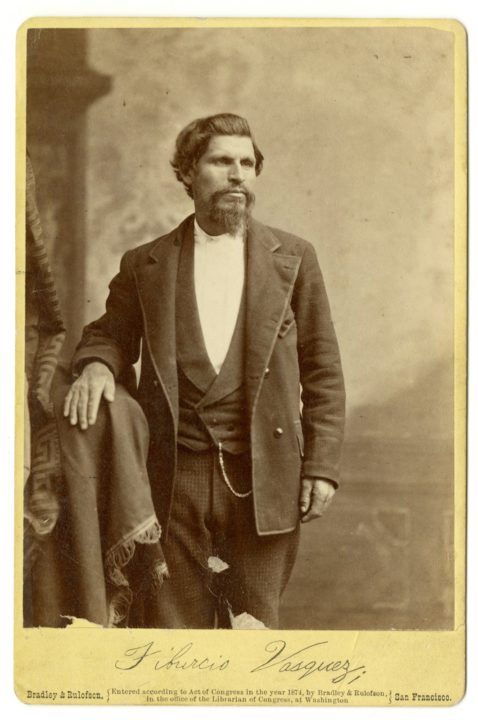
Tiburcio Vasquez, the Gentleman Bandit
Famous for committing numerous burglaries, cattle thefts, highway robberies and participating in several prison breaks and even murders—although he denied ever killing anyone—Vasquez was no ordinary outlaw. Handsome, well-dressed, and educated Vasquez was well-known as a gentleman bandit. He charmed the ladies in both Spanish and English with his chivalry. Unfortunately, his penchant for sleeping with multiple women, some of whom were his friends’ wives, made him some enemies.
And Vasquez’s criminal exploits throughout the state led the Governor of California to post a reward for his capture: $3,000 alive, or $2,000 dead.
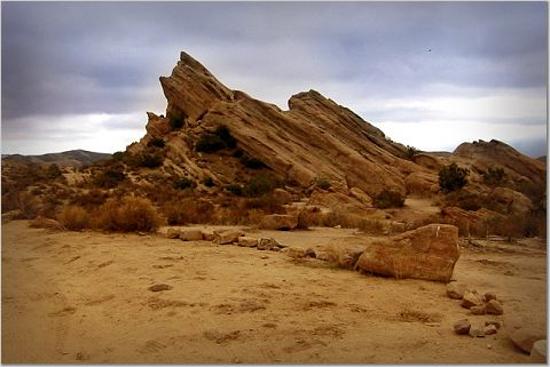
Vasquez Rocks
The manhunt for Vasquez was followed by newspapers throughout California. Vasquez utilized multiple hideouts throughout California including the Vasquez Rocks, in between Santa Clarita and the Antelope Valley, and Vasquez and his men camped out in one of the caves at Piedra Gorda (Fat Rock), which is now called Eagle Rock.
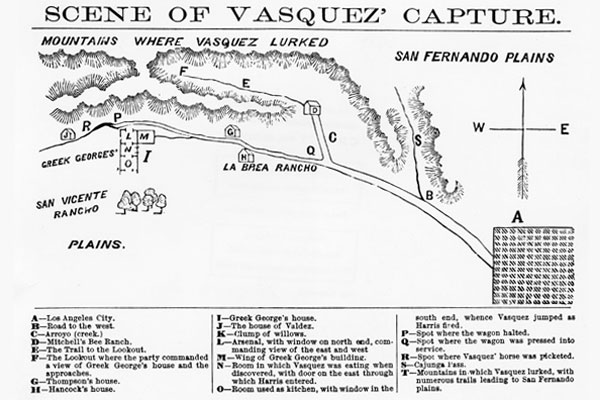
Map image courtesy: KCET.org
By 1874, Vasquez was hiding out in the home of a man named Greek George, a former camel driver for the U.S. Army. Greek George’s house was located in a rural portion of Rancho La Brea and was an ideal hideout. But it was the act of a jealous lover tipped off the law that Vasquez was holed up in what would later be known as Runyon Canyon:
“In the end it was not a criminal act that led to Vasquez’s capture, it was his womanizing. Vasquez caused a scandal when he had a child with his niece, Felicita Vasquez. Felicita’s mother was furious with Vasquez and made her feelings known to her extended family, which included Jose Jesus Lopez, who described Vasquez as “a man of no principle at all.” And Lopez’s cousin, Cornelia Lopez, just happened to be Greek George’s wife. Lopez’s sister, Modesta, with whom Vasquez also had a sexual relationship, became furious when she learned that Felicita had borne Vasquez’s child. Her anger grew when newspapers reported that Vasquez had visited a known prostitute. It is not clear exactly who did it, but some member of the Lopez family notified the authorities that Vasquez was hiding out at Greek George’s house. The tip eventually made its way to Los Angeles County Sheriff William Rowland.” – Robert Peterson,The Hunt for Tiburcio Vasquez: A Chase Through a Californio’s L.A., KCET.org
In 1919 Coal baron Carman Runyon bought the canyon for a riding and hunting retreat and built a small bungalow near the Fuller Avenue entrance for he and his wife. Runyon Canyon Park and Carman Crest Drive at the high northeast point are named after him.

The Los Angeles Times, December 22, 1929
Runyon kept it for a decade before he sold the 145 acres in Hollywood for $500,000 to Irish tenor John McCormick who had fallen in love with the estate while filming an early talkie, Song O’ My Heart there in 1929. An LA Times article about the purchase extols the beauty of the property:
“Although the property is but two blocks from Hollywood Boulevard, its canyon setting is such that it is entirely separated from the outside world and offers quiet and seclusion.” – The Los Angeles Times , December 22, 1929
McCormick and his wife lived in the mansion he built there until they returned to England in 1938. Remains of McCormick’s terraced gardens and buildings can still be seen below the Vista gates.

A number of noteworthy homes stand on Carman Crest Drive where panoramic views have inspired many. The original mid-century home permit approved in 1955 for 2519 Carman Crest Drive was for a one-story house taking full advantage of the views of the city below.

Many creatives took residence here including a director and later a Disney animation artist.

It wasn’t until 2013 that 2519 Carman Crest’s floor plan was expanded to meet the needs of the 21st century. A 2nd story was added, along with every modern update imaginable.
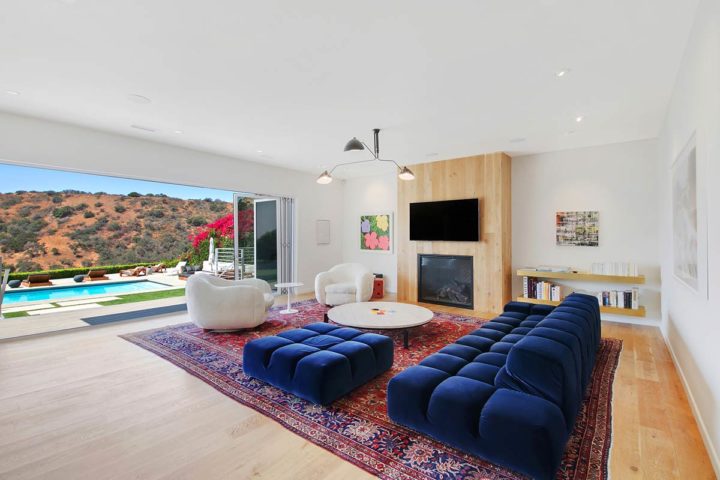
2519 Carman Crest is appointed with finest upgrades throughout: French white oak wide plank hardwood floors, in a spacious open floor plan designed for an entertainer’s whimsy.

Carrera marble countertops, Viking appliances, Bertazzoni range are set into the streamlined design with seamless transitions.

The wine showcase in temperature-controlled glass encasement is an attractive focal point in the dining area, to say the least.

A wall of glass floods the space with natural light and opens to a beautiful patio, magnificent back yard with breathtaking views.

The hilltop oasis takes full advantage of its surroundings. Mid century sensibilities stretch the living space outward into the expansive surroundings where precious privacy is a premium. A modern island amid nature.


The entire upper level is a sprawling, beautiful Master Suite with a fireplace, 2 large walk-in closets, a luxurious bath,


and a private terrace with stunning views.


2519 Carman Crest’s generous level grounds are perhaps what set this home apart.

Meticulously landscaped for privacy, the opportunity for enjoyment is limitless.

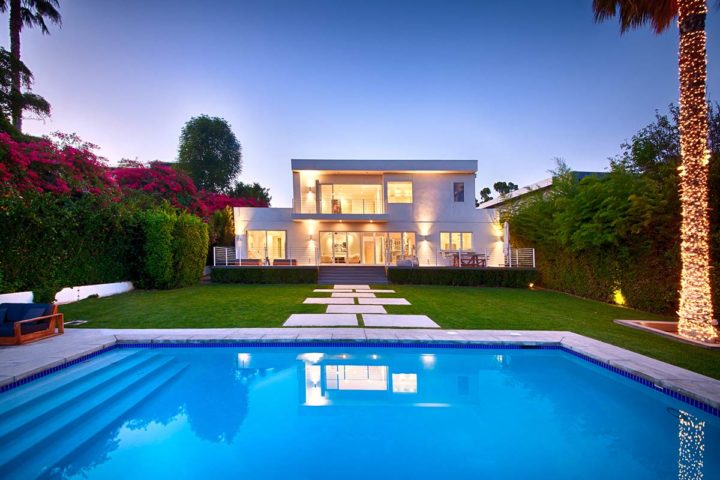
The sparking pool, and lounging areas along the rim of the property are an uncanny retreat. Hard to believe that all the trappings of Hollywood are only minutes away.

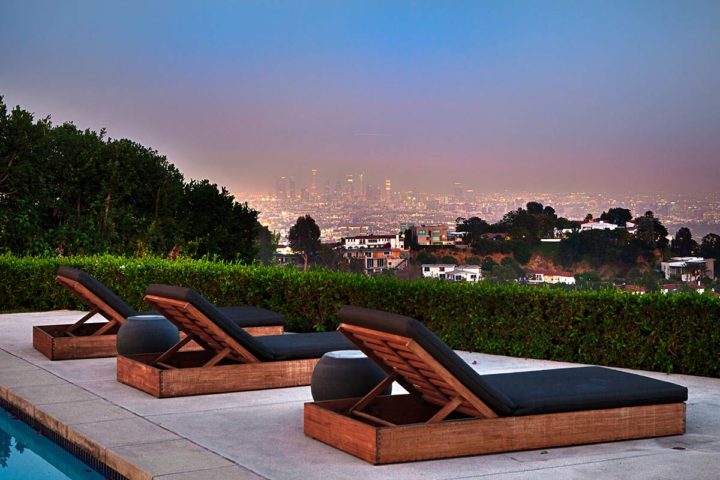
A veritable haven to bask in the sun by day, and fully observe the shift of light from Downtown to the Pacific ocean after sunset.


Leave a Reply
You must be logged in to post a comment.